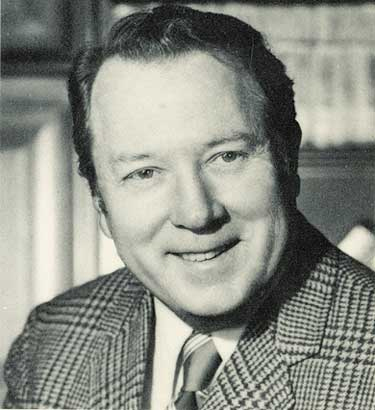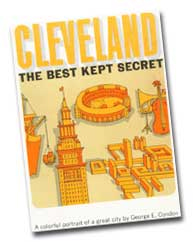George E. Condon, Author
1975 CLEVELAND ARTS PRIZE FOR LITERATURE
 George Condon began his journalistic career at
a time when writing a five-day-a-week opinion column for a newspaper
was, if not common practice, at least far from rare. Yet even as his
peers faded from the scene, Condon continued to produce his own daily
musings and meditations. More important, he never lost the touch: his
last columns in 1985 reflected the same wit, wisdom and amiable prose
style as did his earliest efforts in 1962.
George Condon began his journalistic career at
a time when writing a five-day-a-week opinion column for a newspaper
was, if not common practice, at least far from rare. Yet even as his
peers faded from the scene, Condon continued to produce his own daily
musings and meditations. More important, he never lost the touch: his
last columns in 1985 reflected the same wit, wisdom and amiable prose
style as did his earliest efforts in 1962.
Characteristically, Condon’s good humor pervaded his work right up to the start of a new era in local journalism—an era that would no longer feature his quotidian assessments of events of the day. With a byline as familiar to most Clevelanders as their own signature, it was Condon who chronicled the ups and downs of a city going through its most troubled and tumultuous years, and who helped the old town whistle past the graveyard of its bleakest times.
Although born in Massachusetts, Condon grew up in the Irish neighborhoods of Cleveland’s near West Side, and he spent his entire working career in the city that at various times he lectured, lampooned, lambasted and even loved. He joined the Plain Dealer in 1943 as a general assignment reporter, but he soon invented what he called the “highway beat,” hectoring Ohio gubernatorial candidate Frank Lausche into supporting construction of the state’s first major thoroughfare, the Ohio Turnpike.
As a reward for his efforts, he was named the newspaper’s radio-TV editor in 1948—a time when there was but one television station in Cleveland. But he was given his own general-opinion column on the Op-Ed page in 1962, and for the next two decades he managed to do what few writers before or since have achieved: He earned the attention and respect of hundreds of thousands of habitual readers, and he did it five days a week, rain or shine. During those difficult years in the city, the only constants of a Cleveland morning were a cup of coffee and Condon’s column, a tasty concoction of news, opinions, impressions, insights, memoir, satire, pedantry and no small amount of whimsy. Even during the darkest hours of the 1960s and 1970—when racial unrest, recession, population flight and even municipal default cast a pall over the city and its long-suffering residents—Condon kept a light burning for all those who believed that better times might lie ahead.
 During
his newspaper career George Condon won honors from the Press Club of
Cleveland in four separate categories: public service, headline
writing, humor and general column excellence. He received the
Distinguished Service Award of the Society of Professional Journalists
in 1980, and in 1990 he was inducted into the Press Club’s Journalism
Hall of Fame.
During
his newspaper career George Condon won honors from the Press Club of
Cleveland in four separate categories: public service, headline
writing, humor and general column excellence. He received the
Distinguished Service Award of the Society of Professional Journalists
in 1980, and in 1990 he was inducted into the Press Club’s Journalism
Hall of Fame.
Of the seven books he has authored, five are about Cleveland—its history, its struggles, its failures, its triumphs. Few people have known the town better, from its founding in the 18th century to its renaissance in the 20th. Even fewer have been able to paint in words such engaging, enlightening and entertaining views of a community and its citizens, past and present. And no one will ever again do it with quite so tender a touch.
—Mark Gotllieb
www.lkwdpl.org/lfiles/condon
The Battle of the Bridge
Cleveland and Ohio City were connected at Detroit Street by a floating bridge jointly owned by the two communities. It was a modest, low structure which, however crude and rustic in appearance, served its purpose admirably until the fateful year of 1837, when the City Council of Cleveland abruptly adopted a resolution directing removal of that half of the bridge extending from the east bank to the middle of the river.
This provocative action may be best understood in the light of some backstage finagling by a pair of real estate speculators named John W. Willey and James S. Clark, [who had] built another bridge over the Cuyahoga River where Columbus Street, far to the south of Detroit Street, came down into the valley. Columbus Street was an important highway linking Cleveland with the farmlands and towns to the south. Its traffic formerly had been accustomed to following Pearl Road to the Detroit Street Bridge, passing through the heart of Ohio City, before swinging over the river to Cleveland. Cleveland’s action in severing its half of the Detroit Street Bridge was something else again. It was a transparent effort by Cleveland to divert all the important through traffic to the bridge south of Ohio City, thereby bringing about a major bypass of the rival community to the west.
It is an unconfirmed legend, but likely enough to believe, that a horse-drawn fish wagon, running late toward the marketplace in Cleveland, went careening onto the bridge in the predawn darkness through a heavy mist and rumbled noisily toward its watery surprise. Retaliation was quick. The council of Ohio City declared the hated Columbus Street Bridge a nuisance and ordered the city marshal to “abate” the nuisance “without delay.”
It was Ohio City’s move, and the city marshal, flanked by deputies, strode purposefully onto the bridge and planted some heavy charges of powder. He and his men ran back to the shore, put their fingers in their ears, and cringed in expectation of the explosion—as did everybody in the crowd. But the worst that happened was several sharp popping noises and several large bursts of smoke.
A council of war was held in Ohio City and a date was set for an all-out attack on the bridge. It is estimated that nearly a thousand men from Ohio City and other communities of the county gathered for the attack. Many of them were armed with clubs, rocks, and rifles, and they even had their own chaplain. Dr. Pickands, pastor of the Presbyterian Church, invoked divine aid in behalf of the stalwart force before it began the march to the bridge site with a lawyer, C. L. Russell, in the lead.
When the Ohio City army reached the Columbus Street Bridge, they saw that Cleveland had marshaled a formidable defense. There, across the river, stood a company of militia with muskets in readiness to rake the bridge area. And if this were not enough to quell the Ohio City offensive, Cleveland had also rolled down to the river’s edge an ancient cannon which usually was fired as the highlight of the Independence Day celebrations—continuing the tradition of Uncle Abram Hickox.
Before the opposing forces could enter into any hostilities, a peacemaker suddenly appeared on the bridge. He was none other than John W. Willey, mayor of Cleveland and real estate moonlighter, the villain of the piece. A mighty roar shook the Ohio City side of the bridge when Willey stepped forward and held up his hands for attention. Before he could utter more than a few words, a volley of stones drove him to cover, and the fight, you might say, was on.
—Abridged, with permission of the author, from Cleveland: The Best Kept Secret (Garden City, New York: Doubleday & Company, Inc., 1967)